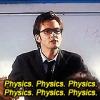Scorpion Season 1 Episode 7: "Father's Day"
Drones! Yes, the flying machines with four propellers that are all too popular these days surfaced in an episode of Scorpion. I thought this might be a cool opportunity to examine the physics of how drones fly. We never get a good look at the drone in the episode, but I do know that its suppose to look like a bird (Sylvester calls it "Bird-Droney"). However, for the sake of this post, I'm going to the discuss the quad-rotor model of a drone (recreational drones). They usually look something like this:

When it comes to the physics of how these things fly, we turn to our good friend Newton and his laws. Guess which law? Yeah, the second one. In case anyone forgot (though I trust you all know this one by now) F=ma. The other fundamental concepts in place here are that velocity (v) is equal position (x) over time (t) or v= dx/dt [in other words velocity is the derivative of position with respect to time] and that, similarly, acceleration (a) is equal to dv/dt [or the derivative of velocity with respect to time/ velocity over time]. First of all, the flight is- for the most part and not accounting for weather and other variables- stable because the force generated by the rotation each of the propellers (which lifts the drone) is coming from four equally space out sources. So now that we know we can lift the drone, how do change it's speed? Here's where Newton comes in. Given F=ma, a=dv/dt, and that m (mass) is constant, the only way to change acceleration and thus velocity, is to vary the force. To vary the force, the propellers have to rotate faster to generate a greater lift force. Since v=dx/dt as well, if vary force and thereby vary velocity, we also change the position (x). There's also the idea that acceleration is the second derivative of position (x) and so from F=ma, varying force also changes the position in that way too. If add a force in the opposite direction, for example, we reduce the acceleration and eventually stop or turn the drone.
This my fairly basic interpretation of some of the research I found. If you want some more information check out this place: http://www.rcgroups.com/forums/showpost.php?p=15973405&postcount=69
Also, the Scorpion episode can be found here: https://www.youtube.com/watch?v=nSzIK2RD4QU
(the quality is wierd, but its the only one I can find. The drone is referenced multiple times so you'll stumble upon it eventually!)
That's all I've got, thanks for reading!



0 Comments
Recommended Comments
There are no comments to display.